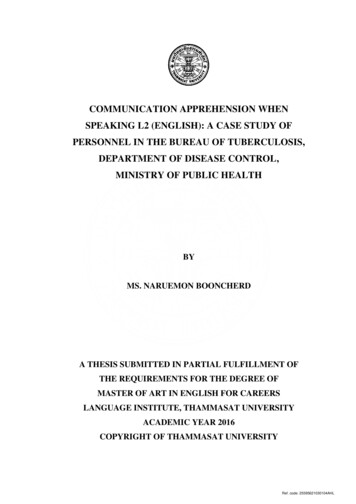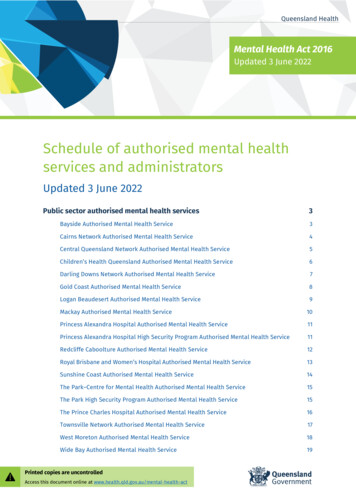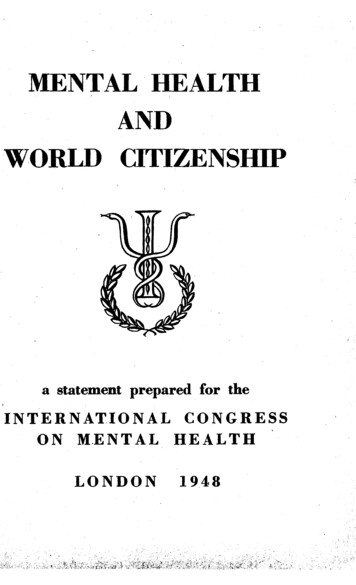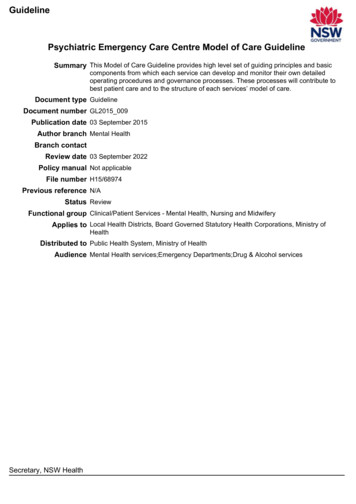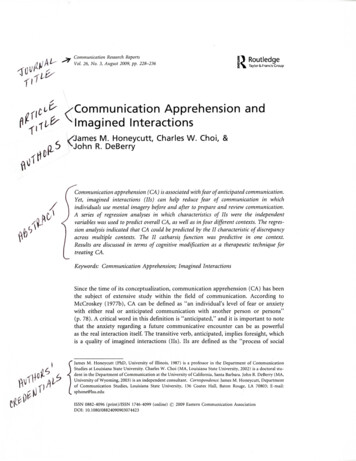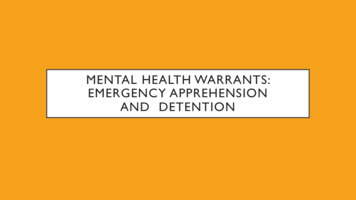
Transcription
MENTAL HEALTH WARRANTS:EMERGENCY APPREHENSIONAND DETENTION
MENTAL HEALTH CRISIS
STATISTICS Non-metro (rural) areas have a significantly higher suicide rate than metro areas. In2015, the rate was 11% for metro areas and 17% for non-metro areas. From 2011 – 2015, Smith County had the highest average suicide rate in Texas. Approximately 20% of state prisoners and 21% of local jail prisoners have “a recenthistory” of a mental health condition Suicide is the 10th leading cause of death in the U.S.,and the 2nd leading cause ofdeath for people aged 10–34. More than 90% of people who die by suicide show symptoms of a mental healthcondition. Serious mental illness costs America 193.2 billion in lost earnings per year. Nehme E, Oppenheimer D, Elerian N, Lakey D. (2017) Suicide in Texas. Austin, TX: University of Texas Health ScienceCenter at Tyler/University of Texas System
WHAT IS AN EMERGENCYDETENTION WARRANT? Sometimes a person who has NOT been arrested isshowing signs of mental illness. Any person may file an application with a magistrate(you!) to issue a warrant to have the personarrested and taken to a mental health facility forevaluation.
WHO IS FILING? Law enforcement? Family members? Physicians?
WHAT IS AN EMERGENCYDETENTION WARRANT? The warrant may only be issued if there is an imminent risk (meaning itis about to happen) that the person will seriously harm themselves orsomeone else. A peace officer may also apprehend someone in this situation ontheir own if the officer does not have time to get a warrant beforethe person is likely to hurt themselves or someone else.
HOW DO YOU GETAN APPLICATION? An application must be presented personallyto the magistrate. Except for a physician who may send itelectronically.Health & Safety Code § 573.011, 573.012(a),(h)
What Does the Application Have to Show?(1) That the applicant believes the person is showing signs ofmental illness and a substantial risk of serious harm to himselfor others;(2) A specific description of the risk of harm;(3) That the applicant believes the risk of harm is imminentunless the person is immediately restrained;
What Does the Application Have to Show?(4) That the applicant’s beliefs are derived from specific recentbehavior, overt acts, attempts, or threats;(5) A detailed description of those specific behavior, acts,attempts, or threats; and(6) A detailed description of the applicant’s relationship to theperson whose detention is sought.-- Health & Safety Code § 573.011(b)
WHAT IS A MENTAL ILLNESS?(14) "Mental illness" means an illness, disease, or condition,other than epilepsy, dementia, substance abuse, orintellectual disability, that:(A) substantially impairs a person's thought, perceptionof reality, emotional process, or judgment; or(B) grossly impairs behavior as demonstrated by recentdisturbed behavior.Health and Safety Code 571.003
EMERGENCY APPREHENSION:ISSUANCE OF WARRANT A substantial risk of serious harm may be demonstrated by:(1) the person's behavior; or(2) evidence of severe emotional distress anddeterioration in the person's mental condition to theextent that the person cannot remain at liberty.Health & Safety Code § 573.012(c)
Form forapplication forwarrant forimmediateapprehensionand detention
T H E M AGI ST R AT EM AY I N T E RV I E W T H EA P P LIC A NT.T H E M AGI ST R AT ES HA LL DE NY THEA P P LICATIO NU NLE S S T H EM AGI ST R AT E FI N D STHERE ISR E A SO N A BLE C AUSETO BE LI E V E T H AT:The person evidences mental illness;The person evidences a substantial risk ofserious harm to himself or others;The risk of harm is imminent (about tohappen) unless the person is immediatelyrestrained; andThe necessary restraint cannot beaccomplished without emergency detention.
ACTIVITY
SCENARIO Call for help with a familymember Resulted in an arrest Family sought suicide watch Moved, but no watch initiated Hung self with clothes ‘Bonded’ out and CPR startedso died outside jail
HOW COULD THIS HAVE BEENPREVENTED?
SCENARIO EPO clearly needed Order granted by the judge After executed, family calls Now has a bed at theirchosen facility and want thecourt to withdraw thewarrant
CAN THIS BE DONE?
NURSING HOME A nursing home files an EDO for a patientwith dementia that keeps wondering away. Can you grant this? Why or why not?
HOSPITAL A hospital files an EDO on a patient butasks for the detention to occur the nextday after the patient’s treatment iscompleted. Would you grant this EDO? Why or whynot?
EDO FROM A FAMILY MEMBER You are concerned that family membersmight file EDO’s on people for ill-conceivedreasons. (Child trying to get at elderly adult’sfinances, divorce/custody cases, etc.) Can you refuse to consider any EDO’s fromfamily members?
NOW WHAT?
WHAT DO YOU DO WITH THE WARRANT? The magistrate shall issue to an on-duty peaceofficer a warrant for the person's immediateapprehension if the magistrate finds that eachelement is satisfied.Health & Safety Code § 573.012(d)
WHAT HAPPENS NEXT? A person apprehended under such a warrant must betransported for a preliminary examination to: The nearest appropriate inpatient mental healthfacility; or A mental health facility deemed suitable by theLMHA, if an appropriate inpatient mental healthfacility is not available.Health & Safety Code § 573.012(e)
WHAT HAPPENS NEXT? The warrant serves as an application fordetention in the facility. The warrant and a copy of the application forthe warrant must be immediately transmittedto the facility.Health & Safety Code § 573.012(f)
ISSUANCE OF WARRANT Once the warrant has issued the person isdetained, transported and evaluated and thecase is out of your hands.Section 573.021, Health & Safety Code
Magistrate’sOrder andWarrant forImmediateApprehensionand Detention
Peace Officer’sEmergencyCommitment
Peace Officer’sEmergencyCommitment
NOTIFIC ATIONTO PERSONDETAINED ONMENTALHEALTHWARRANT
TRANSPORTATION ISSUES You may encounter issues with transportation of persons who aredetained on an emergency detention warrant. In some counties law enforcement is stretched thin with ordinaryduties and feel they do not have the manpower to transport mentallyill patients a long distance to a facility. Sometimes they also have to wait at an emergency room while theperson is examined before going to the mental facility.
TRANSPORTATION ISSUES: The Attorney General recently clarified a magistrate’s authority onthese issues:(1) You have authority to designate a specific peace officer toapprehend and transport the individual regardless of where theindividual is found within the county. For example, a deputy sheriff may be ordered to transportsomeone found within a municipality rather than a municipalpolice officer.
TRANSPORTATION ISSUES:(2) The officer who apprehends the person is responsible fortransporting them to the nearest mental health facility for evaluation. They are responsible for transporting the person until the mentalhealth evaluation occurs. Often, the first stop is at a hospital or ER to get “medical clearance.”The officer must transport the person from the hospital to themental health facility unless the mental health evaluation occurs atthe hospital.AG O P IN IO N KP - 0206
BEST PRACTICES:BUILDING COALITIONS
BEST PRACTICES The key to addressing mental health issues is to work together as ateam with all the stakeholders in your county. This means getting to know your LMHA. And working with the jail staff, other magistrates, prosecutors, yourcounty judge, and mental health experts.
BEST PRACTICES Schedule regular meetings (quarterly or monthly) with all thestakeholders (LMHA, sheriff’s office, magistrates, prosecutors) togo over what is working smoothly and what is not working andneeds to be addressed. Grants may be available through the LMHA for telepsych ormental health deputies.
BEST PRACTICES Smaller counties may wish to band together and have an interlocalagreement. This may allow you to hire mental health deputies towork in each county. Some counties have worked out good procedures for gettingassessments and treatment for the mentally ill but only after workingfor months with all interested parties in the county. It is all about good communication within your county.
MENTAL HEALTH MENTORS Another best practice is to identify a judge who hasexperience in this area to serve as a mentor if you havequestions or concerns about how to handle a specificproblem or matter. TJCTC will help you find a mentor judge in your area, ifpossible. If you would like to connect to a mental health mentor, emailJessica at jessforeman@txstate.edu.
APPLICATION UNLESSTHE MAGISTRATE FINDS THERE IS REASONABLE CAUSE TO BELIEVE THAT: The person evidences mental illness; The person evidences a substantial risk of serious harm to himself or others; The risk of harm is imminent (about to happen) unless the person is immediately restrained; and The necessary restraint cannot be accomplished without emergency detention. ACTIVITY. SCENARIO Call .
